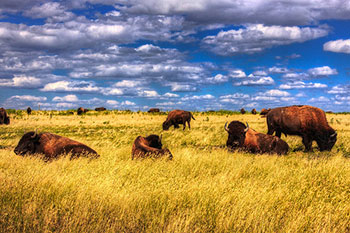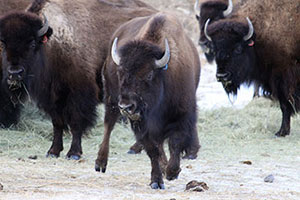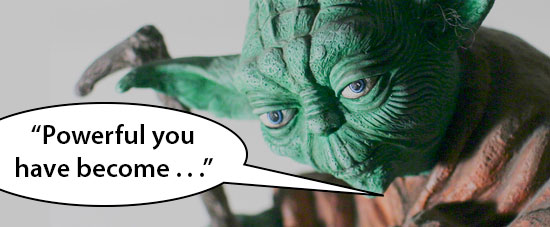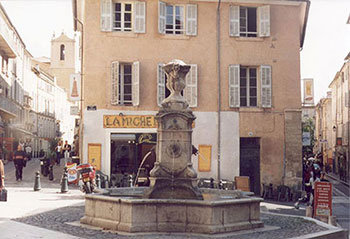Line Length
Good job! Now we are ready to move on to another graphic element used in poetry, the lengths of the lines in the poem. Sometimes poets make every line of their poems identical in length, but other times poets vary the line length for meaning and effect. Read the following poem, and think about why some lines are longer than others.

Source: Mardi Gras World, Eddie Codel, Flickr
Buffalo Dusk
By Carl Sandburg
The buffaloes are gone.
And those who saw the buffaloes are gone.
Those who saw the buffaloes by thousands and how they pawed the prairie sod into dust
with their hoofs, their great heads down pawing on in a great pageant of dusk,
Those who saw the buffaloes are gone.
And the buffaloes are gone.
One of the first things you might notice about this poem is the way that Sandburg repeats the phrase “the buffaloes are gone” four times in such a short poem, most likely to add forcefulness to the fact that the old mythology of the West fades away. The repeated lines create an echo like the “hoofs” that once echoed across the Great Plains.
One of the devices poets use in combination with line length is meter, which refers to the way that some syllables have more emphasis than others. Look at a couple of lines of the poem again, this time with the meter shown. The ‘u’ marks the unstressed syllable and the ‘ / ’ indicates a stressed syllable:

Source: Mardi Gras World, Eddie Codel, Flickr
u / u / u /
The BUFfaLOES are GONE.
u / u / u / u / u /
And THOSE who SAW the BUFfaLOES are GONE.
When the unstressed and stressed syllables alternate in this way, the pattern is known as iambic. When the pattern (u /) occurs five times in one line, the pattern is called iambic pentameter. Notice that the second line of the poem is an example of iambic pentameter.
Now, try to make an inference about the varying line lengths in the poem. Click on the better explanation for why the lines increase and then decrease in the poem.

Word Position

Source: yoda, Benjamin Shockley, Flickr
The last type of graphic element to be aware of is the position of words in a poem. One clever way that poets choose word positions is shown in an acrostic poem, in which the first letters of each line combine to form a word or phrase. Read the following example of an acrostic poem by Lewis Carroll.

Source: Barca - Diamante (CS) Città dei Murales, Caterina Policaro, Flickr
A Boat Beneath a Sunny Sky
By Lewis Carroll
A BOAT beneath a sunny sky,
Lingering onward dreamily
In an evening of July—
Children three that nestle near,
Eager eye and willing ear,
Now look back at the first letters from each line. Do you see the pattern they form? They spell out the word ‘Alice,’ and you might already know that Lewis Carroll is the person who wrote Alice in Wonderland. In fact, this poem is about a boat ride Carroll took with Alice and her siblings and how they liked to listen to his stories.
 The entire poem (this is an excerpt from the full poem) spells out Alice’s full name, Alice Pleasance Liddell. If this poem were simply a sentence, the word order might be very different. Use your notes to write a sentence that contains the same information in the poem, and then click to see a possible response.
The entire poem (this is an excerpt from the full poem) spells out Alice’s full name, Alice Pleasance Liddell. If this poem were simply a sentence, the word order might be very different. Use your notes to write a sentence that contains the same information in the poem, and then click to see a possible response. Sample Response:
On a July evening, in a boat beneath a sunny sky, I lingered with three children, who nestled close by, eager to listen to my stories.
Once a poet decides to write an acrostic poem, he or she must carefully arrange the words so that the first letters of each line form a word or phrase. Another type of poem in which the word position is important is the shape poem, like the one below. Note that the poem is an abridged version.
Fountains of Aix
By May Swenson
Beards of water
some of them have.
Others are blowing whistles of water.
Faces astonished that constant water
jumps from their mouths.
Jaws of lions are snarling water
through green teeth over chins of moss.
Dolphins toss jets of water
from open snouts
to an upper theater of water.

Source: Aix-en-Provence-Fountain-Oct-2001, Daniel Arnold, Wikimedia
Use your inference skills to determine which statement helps to best explain the effect of the shape poem on meaning.

Excellent work. The more you know about graphic elements in a poem, the more fun it is to connect them to meaning.